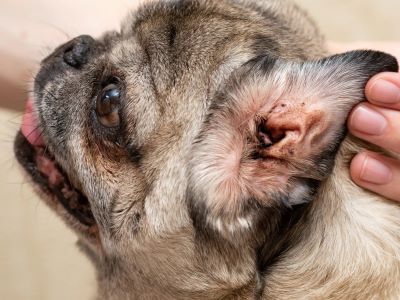Is your dog’s ear smelling bad, or is your dog constantly shaking its head? Can you see dirt and debris in your dog’s ear? If yes then this can be an early indication of yeast ear infection in your dog. now the question is, “How to treat dog yeast ear infection?”
Cleaning a dog’s ear is not an easy task due to which it is avoided by many pet parents. However, this is not the right thing to do. Not maintaining the hygiene of a dog’s ear leads to yeast overgrowth and infection.
Here through this blog, we will let you know everything about what yeast ear infection is, its causes, treatment and ways to prevent it.

Causes of Yeast Ear Infection in Dog
Malassezia pachydermatis is a species of yeast that overgrows in a dog’s ear canal and results in irritation and inflammation. Due to this yeast overgrowth dog suffers from yeast ear infection[1].
Here are some reasons behind yeast overgrowth:
- If while bathing, swimming or playing with water the water enters the dog’s ear then the yeast overgrows. If the ear is not dried properly the moisture is retained which leads to yeast growth and ear infection in dogs.
- Allergies or food reactions can cause yeast overgrowth in dogs.
- Ear mites are conditions in a dog which cause itching and irritation in the dog’s ear. It is spread through coming in contact with an infected dog. These ear mites create a favourable environment for the yeast to grow leading to yeast infection.
- Poor hygiene, and not cleaning your dog’s ear on a regular basis can result in dirt and debris. Yeast tends to grow in such unhygienic environments easily.
- Yeast overgrowth can also be caused due to hormonal imbalances and health conditions. Conditions like Cushing’s disease, diabetes or hypothyroidism can also lead to yeast ear infections in dogs.
As mentioned by Leigh Burkett, DVM in petmd, "Yeast are spore-producing fungi that are always present on a dog’s skin, usually in low numbers, as part of the normal flora. A yeast infection happens when there’s an excessive amount of yeast in a certain area."
Symptoms of Dog Yeast Ear Infection

Here are the symptoms of a dog yeast ear infection:
- Unpleasant bad odour
- Unusual discharge of black, brown, red or green wax
- Dirt and debris
- Ear scratching
- Constant shaking of the head
- Swelling and redness in the ear
- Ear drooping
- Crusting of ear
- Thickened ear flaps
Diagnosis of Yeast Ear Infection in Dog
To diagnose yeast ear infections[2] in dogs you need to visit a vet. A vet may be able to diagnose it better. Here are the following ways that a vet follows for the diagnosis of yeast ear infection in a dog:
Ear swabs
For the diagnosis of yeast ear infections in dogs, a vet will take a sample of the ear discharge on a cotton-tipped applicator. The collected sample will be examined under the microscope to observe the presence of yeast and its type.
This procedure is also used for the diagnosis of bacteria and mites.
Cytology
Cytology is the scientific study of cells it helps in the diagnosis of infections, cancer or genetic disorders. In this process, a vet collects the sample with a special dye and observes it under the microscope.
With this process, it becomes easy for the vet to diagnose the yeast ear infection. Through this process the differentiation between yeast and other cells becomes easy.
Culture
Through this process, the vet collects the sample of the ear wax on a culture medium and incubates it for a few days. The collected sample is then isolated which helps the yeast to grow. This cultural process is used to identify the severity of the infection and its sensitivity.
How To Treat Dog Yeast Ear Infection?
Here are the ways to treat dog yeast ear infections:

Tropical antifungals
In this method of treating the yeast ear infection the ointment containing antifungal agents like miconazole, clotrimazole and ketoconazole is prescribed. You just need to apply this ointment on the infected areas of the dog’s ear.
Tropical antifungals have steroids and anti-inflammatory ingredients that help reduce swelling and itching. The dosage of applying this depends upon the type of infection and its seriousness.
Oral medications
Your vet may suggest oral medications to treat the yeast ear infection. These oral medications consist of antifungal agents such as fluconazole, terbinafine and itraconazole.
This antifungal agent helps to get quickly rid of the yeast from the dog’s body. If the yeast infection is spread throughout the middle and inner ear then your vet is likely to prescribe it.
Ear cleansers
Ear wax, dust and debris just increase the yeast infection making it worse. To treat the infection it is necessary to clean dogs ears. To clean your dog’s ear you can use vinegar, salicylic acid or try rubbing alcohol.
Apart from these ways, you can use other ways or home remedy too for cleansing the ear. By doing so the chances of yeast infection to grow decreases.
Surgery
Surgery is one of the last ways to treat the yeast ear infection in dogs. If the yeast infection is not cured by the above ways or has become worse than before there arises the need for surgery.
If the infection is spread all over the ear then if required the vet can remove the canal. Due to the surgery, there will be temporary effect on the hearing of your dog.
How To Prevent Yeast Ear Infections in Dogs?
Here are the ways to prevent yeast ear infections in dogs:
- Keep your dog’s ears clean and maintain the proper hygiene in them. Clean your dog’s ear on a regular basis to remove dirt and debris. You can even use the vinegar and alcohol solution to clean the ear.
- Keep the dog’s ear dry and clean. After bathing or playing in water dry your dog’s ears properly and make sure there is no moisture left.
- If your dog is allergic to any kind of food then avoid giving him that. Don’t leave any skin allergy left untreated.
- If you notice your dog having any discomfort in the ear, then check and consult a vet immediately.
FAQs
Do dog ear yeast infections go away?
No, the dog ear yeast infection does not go away on its own. To cure the yeast ear infection in dog proper medical care and treatment is required. With proper treatment, it takes about 4 to 6 weeks for the dog’s ear yeast infection to cure. If not treated the yeast infection in the dog’s ear can get worse damaging the canal.
How to treat dog yeast ear infection?
The proper way to treat yeast ear infections in dogs is to consult a vet. A vet may be able to guide you better. Depending upon the seriousness of the yeast infection a vet will suggest treatment accordingly.
Why do dogs get yeast in ears?
The main reason behind dogs getting yeast infections in the ear is an imbalance of microorganisms in the ear canal. The cause behind this imbalance is ear mites, allergies, moisture, weak immune system and hormonal imbalance.
How to clean dog ears?
To clean a dog’s ear you can use the ear cleaners available commercially. You can even use the solution of vinegar and alcohol, make the solution at room temperature dab cotton in it and clean the dog’s ear. You can even take the help of professionals to clean your dog’s ear.
Can I clean my dog’s ears with coconut oil?
Yes, you can definitely clean your dog’s ear with coconut oil. Coconut oil has antibacterial and anti-fungal properties which protect your dog’s ear from any kind of infection. To clean your dog’s ear with coconut oil heat is not making it extremely hot. Just massage the small amount of oil in your dog’s ear and clean it using cotton.
Conclusion
Yeast ear infections can be very discomforting at the same time dangerous. It is very important to treat this infection or else it will keep spreading leading to deafness in your dog. It is very important to check your dog’s ear and clean it on a regular basis.
We hope that through our blog, “How to treat dog yeast ear infection?” you know how to identify the symptoms and treat this infection.
Reference:
- Edgar, J. (2009, December 15). Yeast infection in dogs’ ears: Causes, treatment, and prevention. WebMD.
- Examining and medicating the ears of a dog. (2022, January 4). Veterinary Teaching Hospital.



